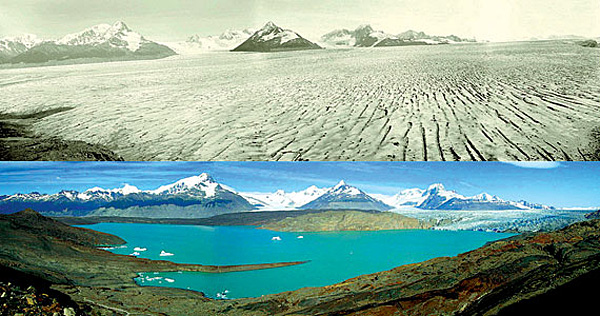
|  |  |  Editorials | Environmental Editorials | Environmental  
Environmentalists Welcome New Law to Protect Glaciers
 Marcela Valente - Inter Press Service Marcela Valente - Inter Press Service
go to original
October 02, 2010


| | Glacier in Patagonia, Argentina 1928. Glacier in Patagonia, Argentina 2004. 76 years of climate change. Then, and now. Scary. (socialvibe.com) |  |
Buenos Aires - Environmental organisations in Argentina are celebrating the passage of a law restricting the extraction of minerals, oil and gas near glaciers, in order to protect these vast freshwater reserves.

By a vote of 35 to 33, the Senate approved the bill to preserve glaciers and their surrounding areas Thursday. Lawmakers supporting the centre-left government of President Cristina Fernández said this time the president would not veto the measure, as she did when Congress passed a similar law in 2008.

In Fernández's view, the 2008 law imposed "excessive" restrictions on industrial activity. According to environmentalists, the new bill just approved is an improvement on the one that was vetoed.

"The 2008 law only restricted mining activity in the glaciers, but this one includes fossil fuel extraction and any industry that uses toxic substances," Hernán Giardini of Greenpeace Argentina told IPS.

Together with Chile, with which it shares a border along the Andes mountains, Argentina harbours the largest glaciers in South America. They are threatened by climate change and industrial activity, especially the mines that have mushroomed over the last 20 years.

In the west-central province of San Juan alone, mining output has increased by 950 percent since 2003, and exports have soared by 4,400 percent since then, according to the provincial government.

San Juan is currently the largest producer of gold and silver in the country. Among the mining projects in the province is Pascua Lama, shared with Chile, which is set to become the world's biggest binational gold mine.

The San Juan provincial government was unanimously opposed to the law to protect glaciers and periglacial areas. "They didn't want any glacier protection law, and when they saw it was inevitable they supported the least restrictive version, but ultimately they lost," said Giardini.

The measure was also resisted by other provinces in northwestern Argentina that harbour large mining investments, such as La Rioja, Jujuy and Catamarca. Water is scarce in this arid region adjacent to the Andes mountain chain, which is rich, however, in metal ores.

The Argentine Mining Secretariat said 900 new mining projects have been registered in the country since 2003, and investments since that date have leaped 1,100 percent thanks to mining laws that helped attract investors.

Five of the 20 largest projects are located in San Juan. The Veladero mine, operational since 2006, and the Pascua Lama project are controlled by the Canadian corporation Barrick Gold.

The new law stipulates that glaciers are "public goods" and forbids "destroying or moving" the huge ice masses. Stiff penalties are set for those who infringe its regulations.

The most novel aspect of the law, according to lawmakers who voted for it, is that it puts the Argentine Institute of Snow Research, Glaciology and Environmental Science in charge of making a nationwide inventory of glaciers.

Once the inventory is prepared, the Institute's experts will vet investment projects in protected areas, and will be empowered to bring extraction work to a halt in mines and oilfields already operating in glacier zones or periglacial areas.

The Environment and Natural Resources Foundation (FARN), an NGO, applauded the passage of the law and highlighted the key role played in its approval by citizen participation, through the proposals of civil society organisations.

"The glaciers and the high mountain valleys will be protected, with their natural resources and huge reservoirs of water which have essential strategic value," María Eugenia di Paola, the head of FARN, told IPS.

In Greenpeace's view, the passage of the law was "a big step by Congress, in spite of the insistent and disproportionate pressure exerted by mining corporations against a glacier protection bill."

According to Giardini, mining companies spent millions on newspaper ads nationwide, urging lawmakers not to support the bill, as well as on consultants who lobbied legislators from mining provinces up to the last minute.

The law also puts major infrastructure projects in the vicinity of glaciers under the scrutiny of the Institute of Snow Research, Glaciology and Environmental Science.

One example is the Agua Negra international tunnel project between San Juan province and Chile, with an estimated cost of 800 million dollars.

It is planned as part of a highroad through the Andes mountains to carry exports from countries of the Southern Common Market (Mercosur) - Argentina, Brazil, Paraguay and Uruguay - to Pacific ocean ports. |

 |
|  |



